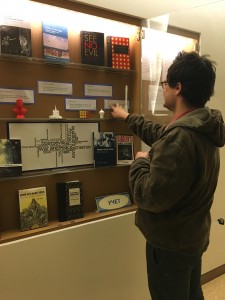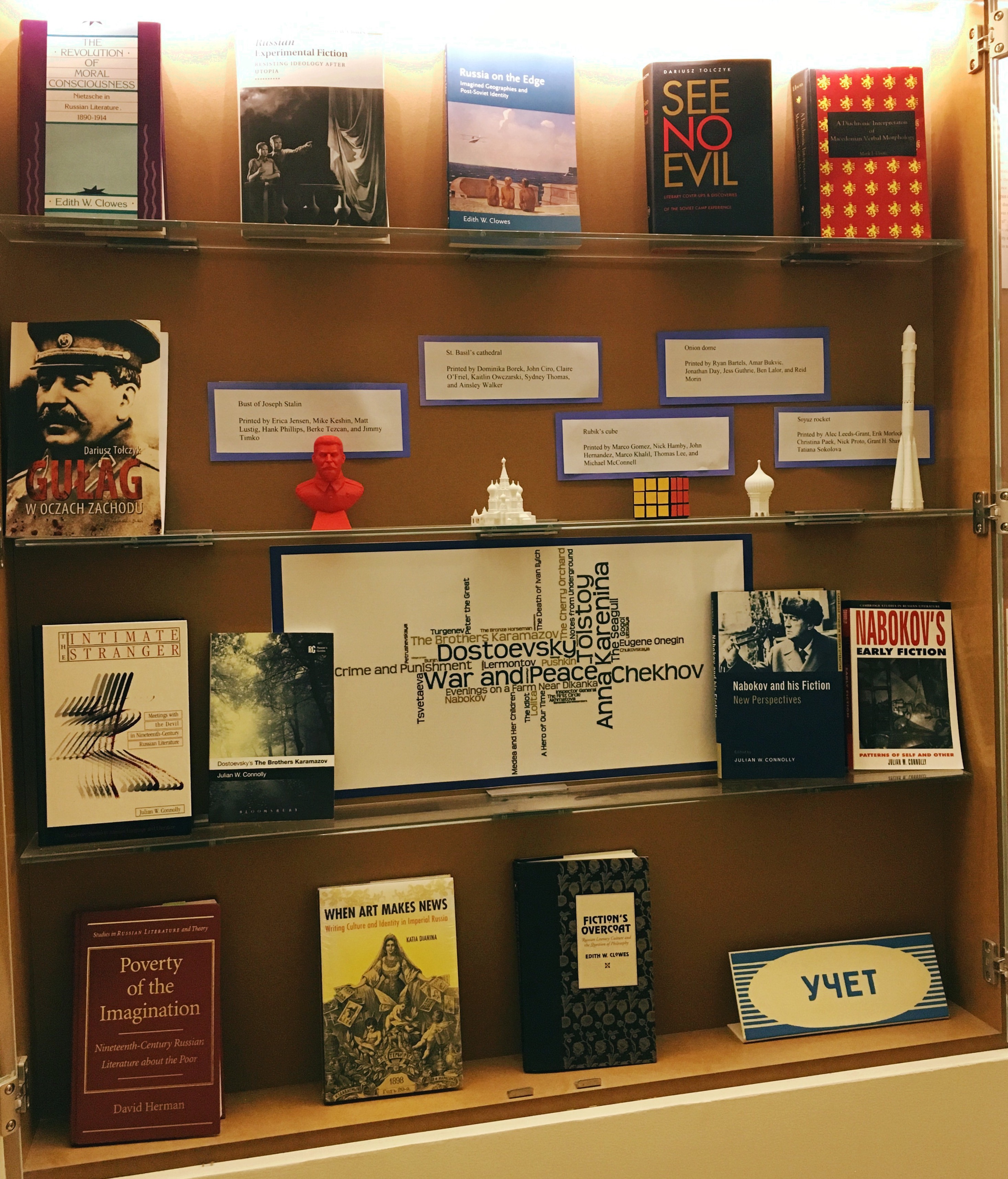3D Printing in the Classroom: Outcomes and Reflections on a Slavic Course Experiment (1/2)
In a previous post, UVA’s Slavic Librarian, Kathleen Thompson, and Slavic Lecturer, Jill Martiniuk, outlined the early stages of a 3D printing assignment for Yuri Urbanovich’s ‘Understanding Russia: Symbols, Myths, and Archetypes of Identity’ course. Kathleen and Jill now describe the unexpected obstacles and opportunities of this assignment in a two part blog post:
If we had to describe this project in two words or fewer, we would definitely do so using the phrase “learning process”. Two days after the original blog post about the project and the accompanying exhibit went live, we had students curate the exhibit of their objects in the hallway of the Slavic Department, on the second floor of Cabell Hall. We had arranged for use of half of a display case that had been occupied by faculty books and items of Slavic ephemera, which we had permission to remove and re-arrange as needed.

Students putting the final touches on their exhibit.
The exhibit curation coincided with the Slavic Department’s biweekly Russian Tea & Conversation event, in which students, faculty, staff, and community members interested in speaking Russian or learning about Russian culture gather to eat, drink tea, converse, and occasionally listen to speakers on special topics. The 2470 students brought their objects to this event, and after a brief introduction to the project from us, they presented their objects to the group and explained why they chose the objects they did. The students then took their objects to the display case and set up the exhibit (for which we had printed a brief blurb and some attributive text).
General response to the project, and the objects, at this event seemed positive, which is why we were quite surprised the next day to hear that one faculty member had a very strong negative reaction to one of the objects in the display case. After some deliberation, we decided to remove the object from the exhibit, and a few weeks later (due to class not meeting because of Spring Break) we discussed this reaction with the students in class.
The object in question was a bust of Joseph Stalin, which the group printed in red. The faculty member who raised the objection is well-known for his work on Stalin’s system of forced labor camps, known as the Gulag. His most recent book on the topic features an image of Stalin on the front cover, which was displayed in the same case in which the students’ exhibition was curated. For an American student whose only experience of Stalin comes from textbooks, using this bust to represent Russia was a positive choice, because Stalin is seen in the U.S. as a strong leader who helped defeat Hitler during World War II. For the objecting faculty member, whose family has personal experience with the effects of Stalin’s policies, the bust carries entirely different connotations: genocide, violence, and turbulence. When we shared this with the entire class, the group that printed the Stalin bust maintained that they stood by their choice, and some of their classmates expressed the common sentiment that Germany is not usually characterized only by Hitler’s negative aspects, so why should Russia be characterized only by Stalin’s? We wanted to emphasize that the students were not in trouble, nor were their project grades affected, and we led them through a discussion of the ways in which their objects can be interpreted as symbols by different groups with various degrees of distance from those symbols. This discussion raised some salient points about the effect of a two-dimensional representation versus a three-dimensional representation, and (for us, at least) really drove home the point that 3D objects absolutely can bring symbols to life in new and unexpected ways.

The finished product. Note the placement of the Stalin bust next to the book at the left.
About a month after that discussion, towards the end of the semester, we gave students the option to re-print their objects if they wished, since at least one group had expressed interest in doing so – the group that printed the Rubik’s cube, for example, had thought about re-making their object to have movable parts. None of the groups chose this option, and headed into the work of their final projects with their original objects intact.
The final project asked groups to complete two assignments. First was a 1,000-word essay addressing the ways in which the group’s view of their object changed, highlighting the following questions: In what ways does your object serve (or no longer serve) as a symbol of Russia? What might better symbolize Russia, or how could your symbol be improved? Did you have any misconceptions in your initial plan to work with this object? What were they? Where did they come from? Is this object ‘loaded’ with any preconceived notions from a Western perspective? From a Russian perspective? The second assignment was to create and give a 3-minute presentation addressing the following questions: What do the objects chosen by the entire class, and the ways the class arranged those objects, say about how we view Russia? What do these objects have in common? How do you think Russians might symbolically represent their views of the United States?
Generally, student groups were satisfied with their objects as symbols of Russia, though each group recognized shortcomings in their initial conceptions of their objects and was able to articulate ways to make their object a stronger symbol. The Stalin group, for example, would have printed a figure of Stalin to represent him as a human being, rather than as a figurehead or an icon on a pedestal, based on the visceral reaction to the bust that could be seen as “glorifying” a figure whose history is murky at best. The group that printed St. Basil’s cathedral felt that their object lacked political symbolism, which they would have changed by adding a 3D model of the Kremlin to surround the church. The onion dome group offered two ideas for improvement: first, making their onion dome a dynamic object with multi-colored layers that represent what they call “the multiple forces at work in Russian society”, or second, printing a model of a nesting doll (matryoshka) to represent the seemingly outwardly-united Russia that depends on one leader at its core. The group with the Soyuz rocket would have changed the color of their object; rather than the white that represents Russia’s multicultural identity, they would have printed a red rocket to emphasize the importance of Communism and revolutions in Russia’s history. They might also have added an astronaut to the rocket, or adorned it with embellishments, to portray Russian opulence created by human hands. The Rubik’s cube group had initially expressed a desire to enhance their object with moving parts; this desire still held true at the end of the semester, though an acceptable compromise would have been to scatter the colors throughout the cube so that it did not have a uniform appearance and could thus express their claim that the puzzle that is Russia has not yet been “solved” in their lifetimes. Finally, the group that printed the scales stated that their object could have been more meaningful if the scales had been movable, rather than fixed, and if each side had had multiple boxes that could be moved to portray the fluctuating power balance between the U.S. and Russia.
As a final note, a few days after classes ended for the semester, I (Kathleen) came across a link on my Twitter feed to a story about upcoming Victory Day celebrations in the Siberian city of Novosibirsk. (Russians celebrate Victory Day every May 9 to commemorate the end of World War II, which they refer to as “The Great Patriotic War”). The story focused on a set of billboards being erected in the city for the celebrations, all of which prominently featured images of Joseph Stalin. This story adds another twist to our discussion of the use of Stalin as a symbol of Russia; for many Russians, he is still seen as a positive figure in the country, despite his treatment of Soviet citizens during his rule. Like the Russian matryoshka doll, the use of Stalin as a representation of Russia is complex and multi-layered, and can be unpacked and re-arranged in a myriad of ways.
In our next post, we will address which parts of this project worked and which did not, students’ and the instructor’s final thoughts on the project, and ideas for improving the implementation of such a project in the future.
